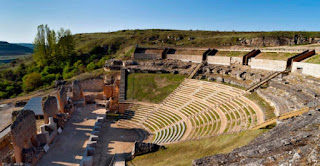How to Secure an Archaeological Site: ASIS Releases New Case Study on Clunia
 |
| Click on the pic above and read the ASIS CRISP Report. |
Protecting heritage during times of war is a topic that receives significant attention. Just read about last October’s Preserving Cultural Heritage in Times of Conflict conference at Colgate University, or Sam Hardy’s recent article about “Curbing the Spoils of War,” or Neil Brodie’s and Isber Sabrine’s new publication titled “The Illegal Excavation and Trade of Syrian Cultural Objects: A View from the Ground.”
Make no mistake, this issue deserves a spotlight because violent conflict creates fresh opportunities to sharply increase the trafficking of cultural heritage objects ravaged from archaeological sites.
But what about protecting archaeological sites during times of peace?
Filling the gap to tackle this important subject are ASIS Cultural Properties Council members and security experts James Clark, Ricardo Sanz Marcos, and Robert Carotenuto. Their peer-reviewed CRISP Report (Connecting Research In Security to Practice) on the Archaeological Site of Colonia Clunia Sulpicia presents a case study for a security plan in a non-conflict region. It should be required reading for all archaeologists, preservationists, security professionals, and others responsible for keeping cultural heritage locations secure.
A copy of the report is available on ASIS International’s web site here.
The three authors–hailing from Clark Security Group, Proarpa (Protección de Activos y Patrimonio), and the New York Botanical Garden, respectively–investigated the challenges and pressures faced by a site located in Peñalba de Castro, Spain, describing Clunia as “the most representative of all of the archaeological ruins that have been found from the Roman period in the Northern Iberian Peninsula.” It is home to a Roman forum, mosaics, statues, and an amphitheater.
The ASIS Cultural Properties Council team conducted their survey and risk assessment with critical help from local stakeholders. They examined “the culture of the site, the site’s vulnerability to looting and various natural and man-made hazards, the local legal requirements that impact the development of a security plan, [and] the available resources to support a new security plan.”
Their conclusions and suggestions employ a broad-based and integrated security model whose features could apply (with site-specific refinements) to other archaeological sites around the globe.
Based on their review of the threats and vulnerabilities to Clunia, the authors recommended the following for Clunia:
[T]he security model must be holistic and maintain a primary mission of delay, deterrence, detection, and prevention of incursions onto the site. The first step is to get the community on board with a sense of ownership. The second step is to provide policies and practices that complement the technology in place and the presence of security officers. The next step is to provide the security officers with tools and technology that optimize their presence on-site and allow them to know when someone is attempting to access the site, either before or when it happens.
The authors’ specific recommendations and the costs of investment and maintenance are outlined in the CRISP Report.
ASIS is a global association of 35,000 private security professionals, including those who work with cultural and religious institutions. CHL’s author is a member of the Cultural Properties Council.
Text and original photos copyrighted 2010-2018 by Cultural Heritage Lawyer, a blog commenting on matters of cultural property law, art law, cultural heritage policy, antiquities trafficking, museum risk management, and archaeology. Blog url: culturalheritagelawyer.blogspot.com. Any unauthorized reproduction or retransmission without the express written consent of CHL is strictly prohibited.

